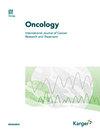Clinicopathological factors predicting pathological complete response to neoadjuvant anti-HER2 therapy in HER2-positive breast cancer.
IF 2.5
3区 医学
Q3 ONCOLOGY
引用次数: 0
Abstract
Introduction Human epidermal growth factor receptor 2 (HER2)-targeted therapies have shown effectiveness against HER2-positive breast cancer. This makes neoadjuvant chemotherapy (NAC) a valuable option for treating both early and advanced stages of the disease. The tumor's response to HER2-targeted NAC provides crucial prognostic information. Additionally, it allows for tailoring adjuvant treatment strategies for HER2+ breast cancer based on pathological responses. This study aimed to investigate the clinicopathological factors that influence tumor response. Methods We retrospectively analyzed 122 patients diagnosed with HER2+ breast cancer. These patients received NAC and HER2-directed therapy between January 2018 and December 2022 at the Pusan National University Yangsan Hospital. Following surgery, tumor response was evaluated, categorizing patients into two groups: pathological complete response (pCR) and non-pCR groups. We analyzed data on various factors, including age, NAC regimen, type of breast and axillary surgery, clinical stage (cTNM), historical grade, and pre-operative levels of carcinoembryonic antigen, cancer antigen 15-3 (CA 15-3), estrogen receptor (ER), progesterone receptor (PR), HER2, p53, and KI-67. Results Out of the 122 patients, 75 achieved pCR, while 47 did not. Most clinicopathological factors showed no significant difference between the pCR and non-pCR groups. However, several factors were associated with a higher pCR rate: normal preoperative CA 15-3 levels (odds ratio [OR]: 3.74, confidence interval [CI]: 1.19-11.72, P = 0.02), preoperative-ER positivity (OR: 2.65, CI: 1.25-5.59, P = 0.01), PR negativity (OR: 3.92, CI: 1.82-8.45, P <0.05), and strong preoperative HER2 immunohistochemistry (IHC) 3+ staining. Multivariate analysis confirmed that PR negativity (OR: 2.8, CI: 1.23-6.42, P = 0.01) and strong preoperative-HER2 IHC 3+ staining (OR: 0.18, CI: 0.03-0.84, P = 0.04) were independent predictors of a higher pCR rate. Conclusions A pCR after NAC impacts patient prognosis and influences the choice of adjuvant treatment for HER2+ breast cancer. Clinicopathological factors can help predict responses to HER2-targeted NAC. In our study, pre-ER/PR negativity, high pre-HER2 levels, and normal CA 15-3 levels were found to be potential predictors of pCR. These findings may contribute to developing more effective treatment strategies for HER2+ breast cancer.预测 HER2 阳性乳腺癌新辅助抗 HER2 治疗病理完全反应的临床病理因素。
导言:人类表皮生长因子受体 2(HER2)靶向疗法已显示出对 HER2 阳性乳腺癌的疗效。这使得新辅助化疗(NAC)成为治疗早期和晚期乳腺癌的重要选择。肿瘤对 HER2 靶向 NAC 的反应提供了重要的预后信息。此外,它还能根据病理反应为HER2+乳腺癌量身定制辅助治疗策略。本研究旨在探讨影响肿瘤反应的临床病理因素。方法 我们对 122 例确诊为 HER2+ 乳腺癌的患者进行了回顾性分析。这些患者于 2018 年 1 月至 2022 年 12 月期间在釜山大学燕山医院接受了 NAC 和 HER2 导向治疗。手术后,对肿瘤反应进行了评估,将患者分为两组:病理完全反应组(pCR)和非完全反应组。我们分析了各种因素的数据,包括年龄、NAC 方案、乳腺和腋窝手术类型、临床分期(cTNM)、历史分级以及术前癌胚抗原、癌抗原 15-3 (CA15-3)、雌激素受体 (ER)、孕激素受体 (PR)、HER2、p53 和 KI-67 的水平。结果 122 例患者中,75 例达到 pCR,47 例未达到。大多数临床病理因素在pCR组和非pCR组之间无明显差异。然而,有几个因素与较高的 pCR 率相关:术前 CA 15-3 水平正常(几率比 [OR]:3.74,置信区间 [CI]:1.19-11.72,P = 0.02)、术前 ER 阳性(OR:2.65,CI:1.25-5.59,P = 0.01)、PR 阴性(OR:3.92,CI:1.82-8.45,P <0.05)和术前 HER2 免疫组化(IHC)3+强染色。多变量分析证实,PR 阴性(OR:2.8,CI:1.23-6.42,P = 0.01)和术前强 HER2 IHC 3+ 染色(OR:0.18,CI:0.03-0.84,P = 0.04)是较高 pCR 率的独立预测因素。结论 NAC 后的 pCR 会影响患者的预后,并影响 HER2+ 乳腺癌辅助治疗的选择。临床病理因素有助于预测 HER2 靶向 NAC 的反应。在我们的研究中,发现前ER/PR阴性、前HER2水平高和CA 15-3水平正常是pCR的潜在预测因素。这些发现可能有助于为HER2+乳腺癌制定更有效的治疗策略。
本文章由计算机程序翻译,如有差异,请以英文原文为准。
求助全文
约1分钟内获得全文
求助全文
来源期刊

Oncology
医学-肿瘤学
CiteScore
6.00
自引率
2.90%
发文量
76
审稿时长
6-12 weeks
期刊介绍:
Although laboratory and clinical cancer research need to be closely linked, observations at the basic level often remain removed from medical applications. This journal works to accelerate the translation of experimental results into the clinic, and back again into the laboratory for further investigation. The fundamental purpose of this effort is to advance clinically-relevant knowledge of cancer, and improve the outcome of prevention, diagnosis and treatment of malignant disease. The journal publishes significant clinical studies from cancer programs around the world, along with important translational laboratory findings, mini-reviews (invited and submitted) and in-depth discussions of evolving and controversial topics in the oncology arena. A unique feature of the journal is a new section which focuses on rapid peer-review and subsequent publication of short reports of phase 1 and phase 2 clinical cancer trials, with a goal of insuring that high-quality clinical cancer research quickly enters the public domain, regardless of the trial’s ultimate conclusions regarding efficacy or toxicity.
 求助内容:
求助内容: 应助结果提醒方式:
应助结果提醒方式:


